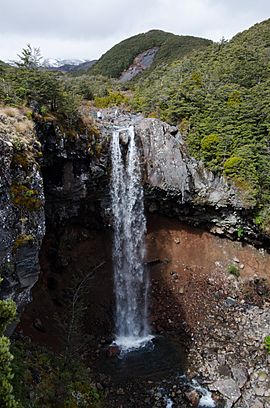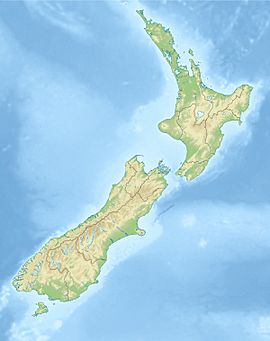Mangawhero River facts for kids
Quick facts for kids Mangawhero River |
|
|---|---|

The Mangawhero Falls on the Mangawhero River
|
|
| Native name | Mangawhero |
| Country | New Zealand |
| Region | Manawatū-Whanganui |
| Towns | Ohakune |
| Physical characteristics | |
| Main source | Mount Ruapehu Tūroa skifield 1,800 m (5,900 ft) 39°18′4″S 175°32′13″E / 39.30111°S 175.53694°E |
| River mouth | Whangaehu River 7 km (4.3 mi) south-west of Mangamahu 50 m (160 ft) 39°51′30″S 175°17′55″E / 39.85833°S 175.29861°E |
| Length | 130 kilometres (81 mi) |
| Basin features | |
| Progression | Mangawhero River → Whangaehu River |
| River system | Whangaehu River |
| Tributaries |
|
| Waterfalls | Mangawhero Falls, Raukawa Falls |
The Mangawhero River is a beautiful river located on the North Island of New Zealand. It's known for its clear waters and the stunning natural areas it flows through. The river gets its name from the Maori words manga, meaning "stream", and whero, meaning "red". So, its name means "red stream"!
Contents
Discover the Mangawhero River
The Mangawhero River starts high up on the south-western slopes of Mount Ruapehu. This is a famous volcano and also home to the Tūroa skifield, a popular place for skiing and snowboarding. The river flows for about 130 kilometers (around 80 miles).
Where Does It Flow?
As the Mangawhero River travels, it passes through the town of Ohakune. This town is often called the "Carrot Capital of New Zealand" because of its farming. After flowing past Ohakune, the river eventually joins the Whangaehu River. This meeting point is located south-west of a place called Mangamahu.
Waterfalls and Scenery
Along its journey, the Mangawhero River creates some amazing waterfalls. Two of the most well-known are the Mangawhero Falls and the Raukawa Falls. These waterfalls are popular spots for visitors to enjoy the natural beauty of the area. The river's path takes it through the Manawatū-Whanganui region, which is known for its diverse landscapes.
Protecting the River
Rivers are very important for the environment and for people. Sometimes, accidents can happen that affect them. On 8 September 1979, about 17,000 liters (or 4,500 US gallons) of heating oil accidentally spilled into the river from the Tūroa ski field. Events like this remind us how important it is to protect our rivers and keep them clean for everyone.


